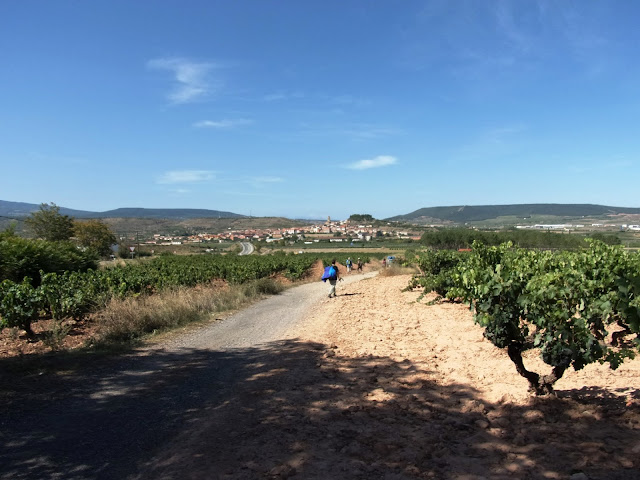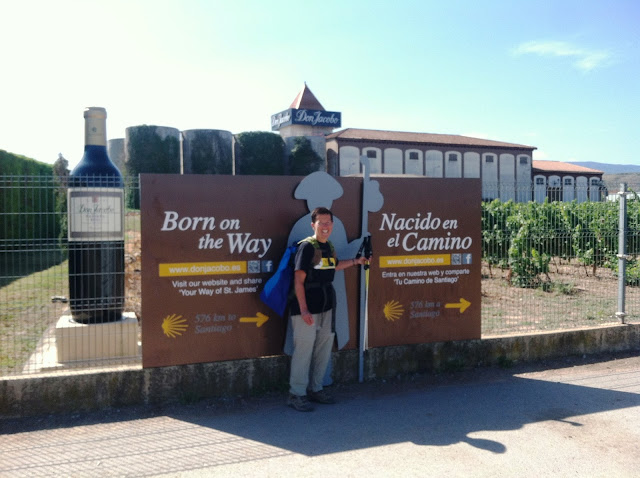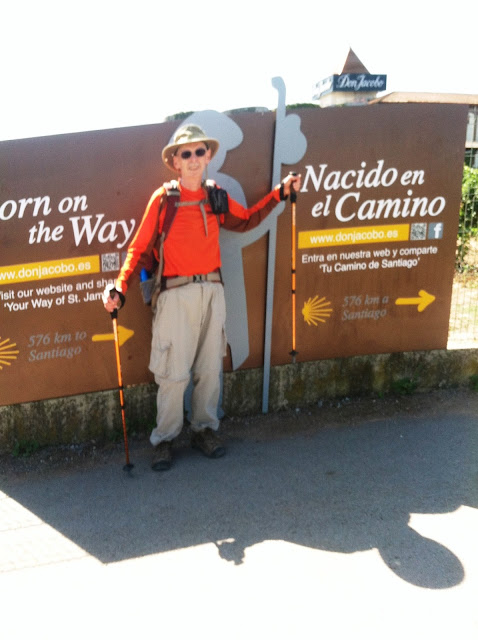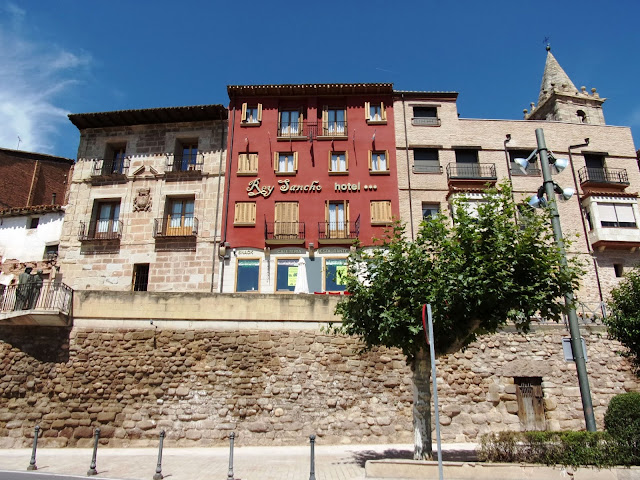We ate breakfast at the lovely Café Noche y Día: 2 tostadas (1 with marmalade, 1 with tomato), 2 coffee, 2 orange juice (total 5.80€). The operator, who was from Transylvania, gave us free Spanish help, and the menu was in Spanish and English.
8:28 AM – Logroño: Café Noche y Día – menu (in Spanish and English) and clerk from Transylvania.
We went to the library to download MT’s photos to flash drive; we thought it opened at 8:15, but it was closed on Saturday. So we departed Logroño around 9:30 am.
9:30 AM – Logroño: sidewalk Camino sign.
Around 10:25, we reached the Pantano de la Grajera reservoir, where the Camino path crossed the dam and then along the reservoir through a pine forest and over a footbridge. (Pantano, like embalse, means reservoir, although both can refer to just the dam.)
10:28 AM – Near Logroño: Pantano de la Grajera reservoir – MT and Don on dam.
10:34 AM – Near Logroño: Pantano de la Grajera reservoir – swans, ducks, and reeds.
10:35 AM – Near Logroño: Pantano de la Grajera reservoir – fish under bridge.
As we approached Navarrete, we passed through several vineyards. (Unfortunately, the bodegas Don had found on the Internet search back in the Logroño library for possible visits near Navarrete were on the highway and not along the Camino route or in the town.)
11:50 AM – Near Navarrete: MT on path through vineyards with Navarrete in distance.
11:50 AM – Near Navarrete: Navarrete in distance (telephoto, 186 mm).
11:50 AM – Near Navarrete: Navarrete in distance, with prominent Iglesia de la Asunción (15x3 telephoto, 360 mm).
Near Navarrete, we passed the ruins of the medieval monastery of the order of San Juan de Acre. It was near the Don Jacobo vineyard and large bodega with a sign inviting pilgrims to visit their website but not the bodega itself (this was not one of the bodegas Don had found on the Internet listing possibility for a visit).
The medieval monastery of the order of San Juan de Acre, founded in 1185; it later became a hospital for pilgrims. Its style was of the transition from Romanesque to Gothic. San Juan de Acre (St. John of Acre) is the name the Knights of the Order of Malta gave the ancient Israeli city of Acre after its capture during the Third Crusade. During the 19th century it was destroyed and the remains were put to other uses. The splendidly carved entrance porch has been re-sited as the gate to the cemetery we would pass on the far side of Navarrete; two windows were also moved there.
12:02 PM – Near Navarrete: Ermita San Juan de Acre; sign says: “Antiguo Hospital de Peregrinos ‘San Juan de Acre’.” Don Jacobo bodega in background and Navarrete still in distance, to right.
12:02 PM – Near Navarrete: closer view of ruins of Ermita San Juan de Acre with Don Jacobo bodega in background,
12:03 PM – Near Navarrete: sign on pavement showing where to stand to take photo with Don Jacobo pilgrim sign.
12:05 PM – Near Navarrete: MT with Don Jacobo pilgrim sign and large wine bottle.
12:03 PM – Near Navarrete: MT with Don Jacobo pilgrim sign (closer up).
12:05 PM – Near Navarrete: Don with Don Jacobo pilgrim sign.
12:07 PM – Near Navarrete: huge “Don Jacobo Reserva Rioja” wine bottle and vineyard.
We arrived in Navarrete (pop 2,200) at 12:30.
The town of Navarrete was founded by the King of Castile as part of a plan to defend his borders, and the name appears to have some relation to the neighboring Kingdom of Navarra. One theory notes that the word Nafarrate in Basque means “Door to Navarra”; the later castellanization of the name would give rise to the present spelling.
When King Alfonso VIII of Castile (1155-1214) recovered this part of La Rioja from the Kingdom of Navarra, he proposed to the inhabitants of the old villages of the zone that they relocate in a defensive place. These villages were known collectively by the name of Corcuetos, and their names were San Llorente, San Antolín, San Pedro, and Nuestra Señora del Prado. The place where they resettled around a fortified castle on a hill called Tedeón became the new villa of Navarrete. The streets of the old part of town form circles or semicircles around that hill. There is a street in Navarrete called Calle de los Corcuetos; there is also a Bodega Torre Corcuetos in the town.
We found Hostal Villa de Navarrete (1 star) with double room for 40€ and got sellos there. We did our laundry and hung it on our balcony.
6:16 PM – Navarrete: Hostal Villa de Navarrete exterior, with our laundry (Don’s orange shirt) on the balcony.
6:10 PM – Navarrete: Hostal Villa de Navarrete – our room No. 201 (view toward window with our laundry).
6:11 PM – Navarrete: Hostal Villa de Navarrete – our room No. 201 (view from window corner).
6:14 PM – Navarrete: Hostal Villa de Navarrete – milk can on staircase (there were 1 or 2 of these on each landing).
We ate the 12€ menú del día (lunch) at Restaurante (Bar Jamanero) El Obrador (the Worker): 1st course: 2 ensalada mixta; 2nd course: 2 dorada (sea fish); dessert: 2 strawberry ice cream (cone); bottle of Rioja wind and bottle of water.
1:24 PM – Navarrete: Restaurante El Obrador Bar Jamanero: Tedeón wine from Rioja (Bodegas Huergo S.L., Navarrete); this was one of 9 local bodegas advertised on the back of the El Obrador lunch menu.
1:26 PM – Navarrete: El Obrador – Don and ensalada mixta of lunch menu.
1:26 PM – Navarrete: El Obrador –ensalada mixta with bread and wine.
1:47 PM – Navarrete: El Obrador – dorado (sea fish) (with flash).
After lunch, we looked around the town. On the way to check at the church for mass time, we found the Oficina de Turismo [tourist office], located under the plaza, and got brochures of Najera, Santo Domingo, and a booklet about “The Way of St. James” in Rioja. We also got sellos there. We also passed the 3-star Hotel Rey Sancho, where we had stayed last year (house rules had said no hanging laundry from windows). We found Iglesia de la Asunción (Church of the Assumption), where we would go to mass later.
2:38 PM – Navarrete: MT with statues near Hotel Rey Sancho, on balcony off Calle Mayor Alta, overlooking Calle Mayor Baja.
2:39 PM – Navarrete: view from Calla Mayor Baja up to statues (on balcony at left) and Hotel Rey Sancho on Calle Mayor Alta; Church of the Assumption tower at right.
2:39 PM – Navarrete: Hotel Rey Sancho exterior (note: no laundry).
We stopped at the Panedería Azofra bakery to buy bread and also picked out some small pastries. The young owner threw in 2 Spanish doughnuts gratis.
2:50 PM – Navarrete: Panedería Azofra – bread and pastries on shelves.
2:51 PM – Navarrete: Panedería Azofra – owner getting bread and pastries for us (he gave us 2 doughnuts).
2:51 PM – Navarrete: Panedería Azofra – MT and owner.
3:05 PM – Navarrete: Panedería Azofra exterior – sign said they closed at 3 pm (so we just made it).
3:03 PM – Navarrete: pruned trees (someone told us last year they were maples).
6:56 PM – Navarrete: Camino marker on street/sidewalks.
We had read in the Rioja Camino booklet about a Romanesque capital on La Cruz street representing 2 knights fighting, and the historical marker at Poyo de Roldán said there was a capital of Roldán and Ferragut on Calle La Cruz in Navarrete. We asked the man at Hostal Villa de Navarrete and ladies on La Cruz street, but nobody knew where it was. Later, Don found it directly across the street from our hostal door (just high up on a wall, where we hadn’t noticed it). Don went back to our room, told MT “You won’t believe where I found it,” and had her look out our window. (See further notes on Roldán and Ferragut on August 24.)
7:08 PM – Navarrete: Calle La Cruz from Hostal Villa de Navarrete (door on right) with Roldán and Ferragut capital on wall above white car on left.
7:07 PM – Navarrete: Roldán and Ferragut capital with inscription: “NAVARRETE - En el milenario de su fundación rinde homenaje en este capitel a los antigous Corcuetos demolibos por voluntad para elevar esta villa fortaleza – San Pedro, San Antolin, San Llorente, Ntra. Sra del Prado – CMLXXVI – MCMLXXVII” [NAVARRETE – On the millennium of its foundation rendered homage in this capital to the ancient Corcuetos demolished willingly for erecting this fortified villa - San Pedro, San Antolin, San Llorente, Nuestra. Señora. del Prado - 976 – 1977.]
A newspaper article in La Rioja, Nov 10, 1996 identifies this as a Romanesque capital of the 11th century. San Pedro, San Antolin, San Llorente, Nuestra. Señora. del Prado, collectively known as Corcuetos, were the four villages abandoned when inhabitants moved to the newly created fortified villa of Navarrete for better defense against Navarra.
The website www.sasua.net says that this capital is from the former chapel of San Pedro and points out that it clearly shows a fight between two Christian knights, both carrying a Norman shield (the standard shape for Christians), versus round shields of pagans).
9:17 AM – Navarrete: Roldán and Ferragut capital (close up).
7:34 PM – Navarrete: view out our window in Hostal Villa de Navarrete: laundry on balcony with view through balusters of capital of Roldán and Ferragut on wall of building across street.
7:35 PM – Navarrete: view out our hostal window of building across street with Roldán and Ferragut capital.
Sunday, August 24, 2014 8:27 AM - Navarrete: old building across Calle La Cruz from our hostal window, just above Roldán and Ferragut capital, with someone else’s laundry.
7:07 PM – Navarrete: old building across Calle La Cruz from our hostal window, with arcade and coat of arms.
7:08 PM – Navarrete: close-up of that coat of arms (telephoto, 156 mm).
We went to mass at the 16th-century Iglesia de la Asunción (church of the Assumption) at 8 pm. (For the third day in a row, a priest wore white vestments.) At the end of the mass, there was a pilgrim blessing.
In the early 16th century the former main church of Navarrete, located at the top of the Tedeón hill next to the castle, was already uncomfortable and small. Thus, it was considered appropriate to request license (issued by the Bishop of Castilla in 1523) to build another church in a wider and lower place. That, too, soon became too small and was demoloshed in 1553.
The present Iglesia de la Asunción is a Renaissance church of considerable size, whose construction lasted for nearly a century, begun in 1533 and concluded in 1645. The dual front entrance of the portal on the south side was conceived as an altarpiece of two bodies; an image of the Assumption is in a niche at the top. The tower, with pyramidal spire, was completed in 1629.
The present Iglesia de la Asunción is a Renaissance church of considerable size, whose construction lasted for nearly a century, begun in 1533 and concluded in 1645. The dual front entrance of the portal on the south side was conceived as an altarpiece of two bodies; an image of the Assumption is in a niche at the top. The tower, with pyramidal spire, was completed in 1629.
2:30 PM – Navarrete: Iglesia de la Asunción – view up the Calle de Santiago from Calle La Cruz, with Turismo office in archway under plaza on right.
3:14 PM – Navarrete: Iglesia de la Asunción – exterior from plaza.
2:31 PM – Navarrete: Iglesia de la Asunción – exterior with façade above entrance (at bottom is top of head of one of the statues on Calle Mayor Alta overlooking Calla Mayor Baja and the square).
7:48 PM – Navarrete: Iglesia de la Asunción – nave toward main alter (partially lit).
8:35 PM – Navarrete: Iglesia de la Asunción - nave toward main alter (fully lit after mass).
The main altarpiece, created in 1694-1698 and renovated in 1713, is one of the best examples of Baroque reredos in La Rioja.
7:50 PM – Navarrete: Iglesia de la Asunción – old-looking Madonna and Child on side altar.
Navarrete: Iglesia de Santa Maria de la Asuncion – statues of Santa Rufina and Santa Justa (with earthenware pots) at right rear of nave near entrance (commons.wikimedia.org).
Saints Justa (born 268) and Rufina (born 270) are said to have been martyred in Seville during the 3rd century. According to legend, they were sisters, born of a poor but pious Christian family, who made earthenware pottery for a living, with which they supported themselves and the city’s poor. During a pagan festival, they refused to sell their wares for use in these celebrations. In anger, locals broke all their dishes and pots, and the sisters retaliated by smashing an image of Venus. For this, they were imprisoned without food or water, and they both died in 287. Justa died first, her body thrown into a well. The Roman magistrate thought the death of Justa would break the resolve of Rufina. However, Rufina refused to renounce her faith and was thrown to lions in the amphitheater. When the lions refused to attack Rufina, she was strangled and beheaded and her body burned. The local bishop recovered both bodies for a proper burial. (Some sources say the magistrate ordered them to be stretched on a rack and their sides torn by hooks; Justina died on the rack and the magistrate ordered Rufina to be strangled, and both their bodies were burned. Other sources report yet other forms of torture. Thus, the accounts of their martyrdom are unreliable, and one of them seems to have undergone a change of sex over the ages, for Justa was originally called Justus.)
7:46 PM – Navarrete: Iglesia de la Asunción – baptismal font.
At the rear of the nave were display cases with old vestments, old music books, and curious figurines of hooded men, some playing drums.
7:47 PM – Navarrete: Iglesia de la Asunción – vestments, old music book, and figures with hoods (some pointed) in display case at rear of nave. Green and white figure with drum at left has inscription: “VIII Exaltación de Bandas ‘CIUDAD DE ARNEDO’ Semana Santa 2011” [7th Exaltation of Bands ‘CITY OF ARNEDO’ Holy Week 2011]. (Arnedo is a town in La Rioja.)
7:47 PM – Navarrete: Iglesia de la Asunción - vestments, old music book, and more figures with pointed hoods (some with drums) in display case at rear of nave.
7:47 PM – Navarrete: Iglesia de la Asunción - vestments, old music book, and figures with hoods (some pointed) in display case at rear of nave. White figure at far left rear has inscription: “IV Exaltación de Bandas de Cofradías y Hermandadas COFRADÍA DEL SANTO CRISTO – LARDERO - Semana Santa 20__” [4th Exaltation of Bands of Brotherhoods and Sororities BROTHERHOOD OF THE HOLY CHRIST - Lardero - Holy Week 20__]. Blue and white figure at left has inscription: “II Exaltación de Bandas de Cofradías y Hermandadas ‘Cofradía del Santa Cristo’ Lardero 2010” [2nd Exaltation of Bands of Brotherhoods and Sororities ‘Brotherhood of the Holy Christ’ Lardero 2010]. Green and white figure at right has inscription: “VII Exaltación de Bandas ‘CIUDAD DE ARNEDO’ 6 – Martzo - 2010” [7th Exaltation of Bands ‘CITY OF ARNEDO’ – March 2010]. (Lardero and Arnedo are towns in La Rioja.)
The web site www.aytolardero.org had article about “los miembros de la Cofradía y de la Banda de tambores y trompetas del Santo Cristo” [the members of the brotherhood and the band of drums and trumpets of Santo Cristo] during Holy Week 2012. (For more information about cofradias and hermanadadas, see notes on September 11 in Astorga.)
We bought ham, butter, and marmalade for supper in our room (along with bakery purchases from earlier).



















































No comments:
Post a Comment